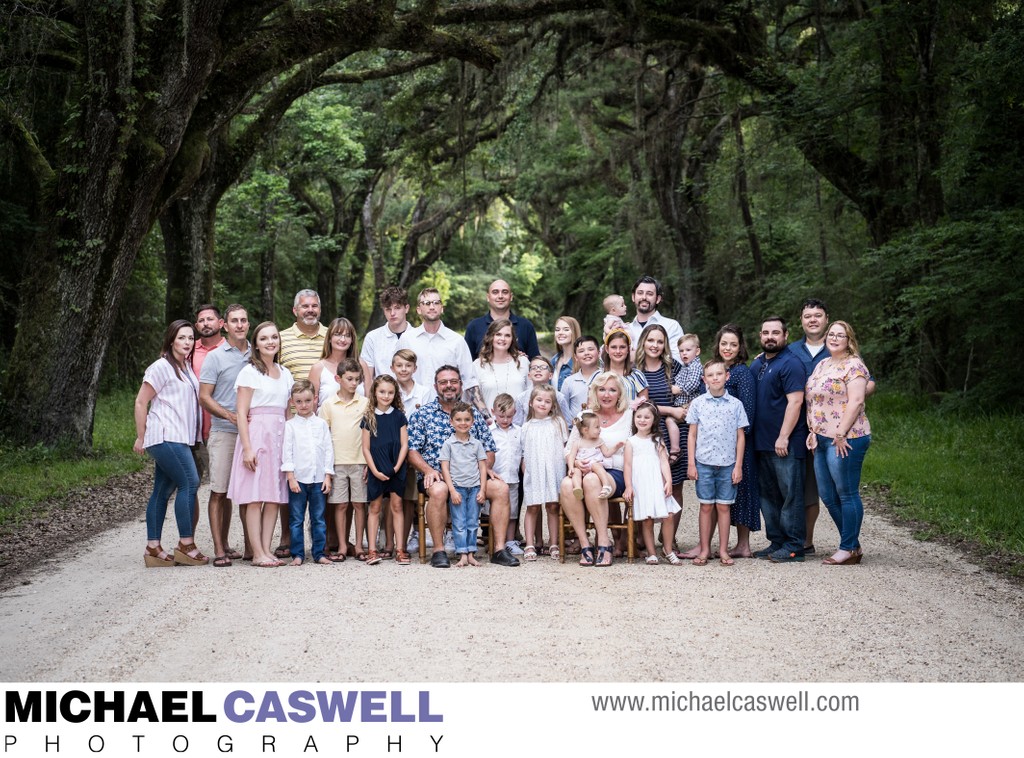
I was delighted when a past bride from a Bay St. Louis Mississippi wedding over ten years prior contacted me to ask about photographing her family. And not just the two of them and their kids, but parents, siblings, and their kids as well! She suggested that we do the portrait session in Logtown, MS, which is near Pearlington.
I arrived a bit early to scope out exactly where we would be shooting, and immediately gravitated toward simply shooting right in the middle of the gravel road, since I knew we'd have a big group to shoot and needed plenty of space (this is out in the middle of nowhere, so there's virtually no vehicle traffic... just an occasional truck heading to the boat launch). While there was also a wooded area near the cemetery with a reasonable amount of space to work with, I really wanted a more open look, with more distance between the family and the background, and multiple layers of elements. So, I drove up and down the road a few times looking for the spot that would have the most aesthetically pleasing full canopy of trees in the background. In addition to this full group shot of everyone, we did various combinations of smaller family groups.
Logtown has a fascinating history. Once the site of the largest sawmill in the country, H. Weston Lumber Company, and with a population of 3,000, it was a bustling town located on the Mississippi side of the Pearl River. But by 1930, the supply of usable timber in the area had been depleted, and the company went out of business. With Logtown's primary industry and employer gone, the town's population dwindled to around 250 people, but these die-hard residents loved where they lived and considered it a paradise.
They were forced to relocated in the 1960s when, with NASA gearing up for the race to land Americans on the moon, the agency built the nearby Stennis Space Center. Because that facility's main purpose was to test extremely loud engines for the Saturn V rockets that would launch the Apollo capsules into orbit and beyond, the agency designated an acoustic buffer zone consisting of 125,000 acres of land surrounding Stennis, which was to be uninhabited by people. This area encompassed several existing small towns such as Logtown. Residents were relocated, with some of the homes being moved, and others demolished, and the towns essentially being erased from existence.
An informational sign near the cemetery reads:
In the early 1900's, there were 2,000-3,000 residents of Logtown. There was a two-story general store, company offices, homes built in rustic versions of the popular Queen Anne style, a public school with classes through 12th grade, several wooden churches, boarding houses for loggers and the Hancock County Bank. Because there was heavy boat traffic on the river coming from New Orleans, mail was delivered twice daily.
Logtown was relocated in 1964 by NASA because of its proximity to the rocket engine test facility. Twelve graves from the Gainesville Cemetery were reinterred to the Logtown Cemetery. Among the 435 graves in this cemetery, look for aboveground mausoleums, Woodmen of the World markers, and the oldest grave, dated 1853 of Florence Louise Hoffman, which was reinterred from Gainesville Cemetery. The oldest original grave is Leonard Kimball W_(last name illegible), who perished in 1868.
Possum Walk was an African-American town site on the north side of the Bogue Homa. There was a ferry crossing from Logtown to the settlement of freed slaves. A great many of the sawmill employees were of African descent.
Today, the only readily apparent sign of the town's past history that remains is the cemetery. Nature has otherwise almost fully reclaimed the area, with only some scattered remnants of the habitation and industry that once thrived here. A nearby nature trail, called the Possum Walk Trail, is a bit over six miles long, and goes from Logtown to the Infinity Science Center, where, ironically, the first stage of an unused Saturn V rocket is on display, the testing of which resulted in the town's demise.
Location: Logtown, MS.